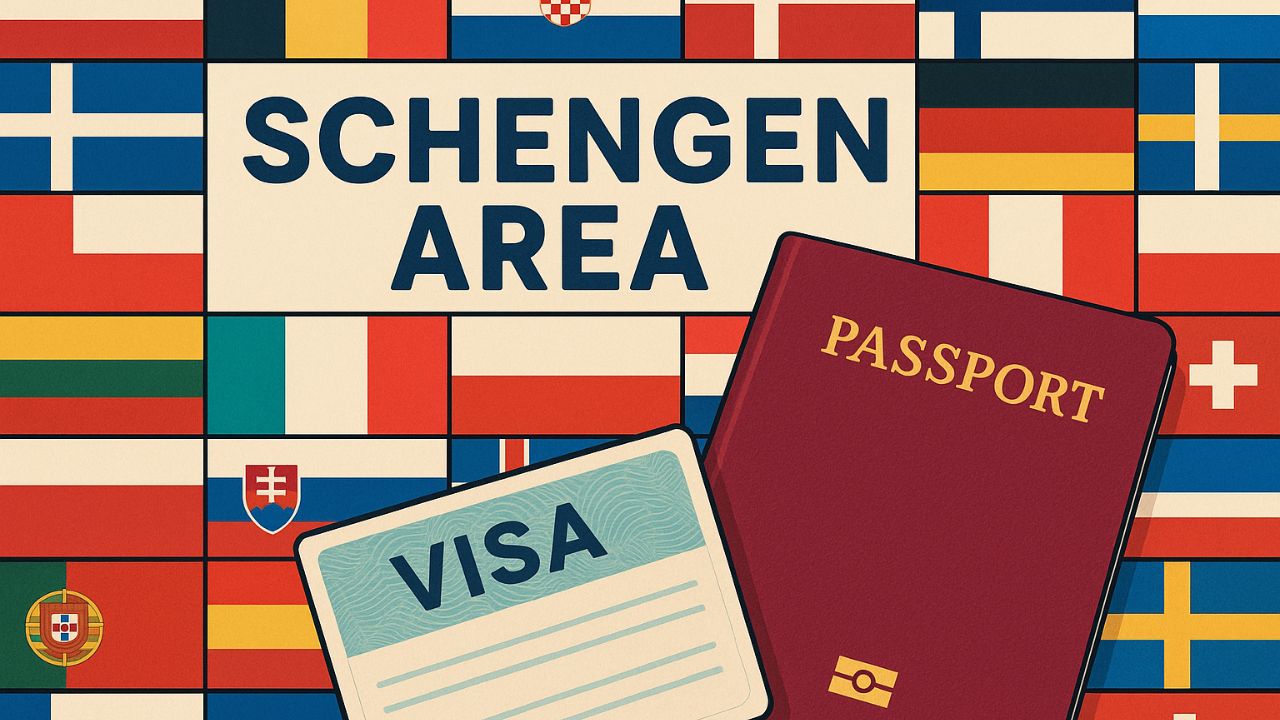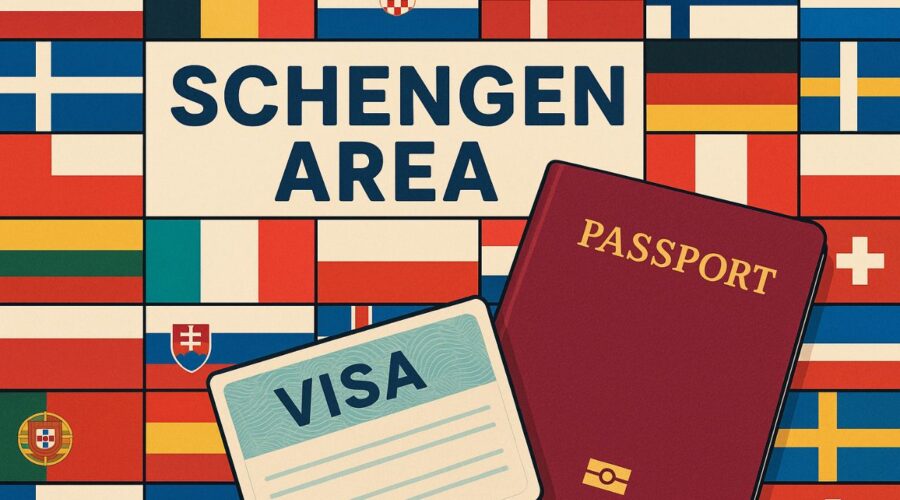
Planning a European getaway or a business trip from India? If your travel itinerary includes countries like France, Germany, Italy, or Spain, you’ll likely need a Schengen visa. This visa allows Indian passport holders to visit and move freely across 29 European countries within the Schengen Area for up to 90 days within a 180-day period. Whether you’re travelling for tourism, visiting family, attending conferences, or simply exploring, the Schengen visa simplifies access to multiple European nations with just one visa.
For Indian citizens, the application process involves choosing the right country to apply to—typically the one where you will stay the longest, or the country you enter first if your stay is equally divided. In this guide, we’ll break down everything you need to know in 2025—from types of Schengen visas, required documents, and visa fees to processing time, validity, and where to apply in India. Let’s make your European dream trip easier to plan and apply for!
Table of Contents
What is a Schengen Visa?
A Schengen visa allows non-EU/EEA/Swiss citizens, including Indian passport holders, to travel freely across 29 European countries in the Schengen Area for up to 90 days within a 180-day period. Whether it’s for tourism, business, or visiting family, this visa is your key to exploring much of Europe without border restrictions between member countries.
For Indian travelers, applying for a Schengen visa involves submitting an application to the country where they will spend the most time, or, if time is equally divided, to the country they plan to enter first. While the process may seem complex, being well-prepared and following the right steps can significantly ease the journey. Europe continues to be a dream destination for many Indians, and with the right planning, that dream can become a reality.
Key Aspects of the Schengen Visa for Indian Citizens
If you’re an Indian citizen planning a trip to Europe, understanding the Schengen visa is essential. This visa grants access to 27 European countries with just one permit, making travel smooth and seamless. Here’s a quick overview of everything you need to know:
| Aspect | Details |
| Purpose | The Schengen visa allows Indian citizens to stay in the Schengen Area for up to 90 days within a 180-day period. It covers travel for tourism, business, visiting family or friends, attending cultural events, or short educational programs. |
| Application Process | Start by filling out the visa application form online. Submit all required documents, pay the visa fee, and attend a personal interview (if needed). Appointments are made through the embassy or authorized visa centers. |
| Required Documents | You’ll need a valid Indian passport, completed application form, recent passport-sized photographs, proof of accommodation, round-trip travel itinerary, valid travel insurance (minimum €30,000 coverage), and evidence of sufficient financial means. |
| Visa Fees | The fee is €80 for adults and €40 for children aged 6–12. Children under 6 years of age are exempt from the visa fee. |
| Processing Time | Processing typically takes 15 to 30 calendar days. However, applying at least 45 to 60 days before your intended travel date is strongly advised to avoid delays. |
| Choosing the Right Country | Apply at the embassy or consulate of the country where you plan to spend the most time. If your stay is evenly split, apply through the country of first entry. |
Why do Indians need a Schengen visa?
Indian citizens require a Schengen visa because India is not part of the Schengen Area, and thus its citizens need authorization to enter and travel freely within the Schengen Zone for short stays. This visa allows entry for tourism, business, or family visits, enabling travel to 29 European countries for up to 90 days in a 180-day period. Without a Schengen visa, Indian citizens would not be able to enter or travel within the Schengen Area.
Types of Schengen Visas
When planning to visit any of the 27 Schengen countries, it’s crucial to understand the different types of Schengen visas available. Each visa type is designed to cater to specific travel purposes—be it tourism, business, study, or transit. Here’s a clear breakdown to help you choose the right visa for your travel needs:
| Visa Type | Purpose | Validity | Ideal For |
| Type A – Airport Transit Visa | Allows travellers to transit through the international zone of a Schengen airport without entering the country. | Valid only for airport layovers | Passengers catching connecting international flights |
| Type B – Short-Stay Transit Visa | Extends the transit permission of Type A, allowing up to 5 days of travel through Schengen countries. | Up to 5 days | Road or air travellers passing through multiple states |
| Type C – Short-Stay Visa | Permits stays of up to 90 days within a 180-day period for tourism, business, or family visits. | 90 days within 180 days | Tourists, business visitors, family or friends |
| Type D – Long-Stay Multiple Entry Visa | Grants stays longer than 90 days and allows multiple entries into Schengen countries. | Over 90 days (varies by country) | Students, employees, long-term residents |
Choosing the correct visa ensures smoother travel and compliance with immigration rules. Always verify with the specific embassy or consulate before applying.
Schengen Visa Fees (Effective 2025)
- Adults: €80 (₹7,200 approx)
- Children (6-12 years): €40 (₹3,600 approx)
- Children under 6 years: Free
- Radvision World Processing Fee: €20-25 (₹1,800-₹2,200 approx)
Processing Time & Validity
Planning your travel well in advance ensures a smooth visa experience. Here’s a quick overview of the typical timelines and validity period for your visa application:
| Details | Information |
| Standard Processing Time | 15 to 30 days |
| Recommended Application Time | At least 45 to 60 days before your departure |
| Visa Validity | 90 days within a 180-day period |
Starting early helps avoid last-minute hassles and ensures you have ample time for any additional documentation or queries.
Documents Required for a Schengen Visa: What You Need to Prepare
Planning a trip to Europe? One of the most important steps is securing a Schengen visa. To make the application process smooth and stress-free, it’s essential to gather all the necessary documents in advance. Here’s a clear breakdown of what you’ll need to get started:
| Document | Details |
| Valid Passport | Must be valid for at least six months beyond your intended stay, with at least two blank pages. |
| Visa Application Form | Fully completed and signed by the applicant. Available on the official embassy website. |
| Passport-Sized Photos | As per Schengen photo specifications—recent, in color, and with a white background. |
| Flight Reservations | Proof of your travel itinerary—bookings only, no need to purchase tickets at this stage. |
| Accommodation Proof | Hotel bookings or an invitation letter if staying with friends or family. |
| Travel Insurance | Must cover at least €30,000 for medical emergencies, valid across all Schengen states. |
| Financial Documents | Latest Income Tax Returns (ITR) and bank statements as evidence of financial means. |
| Cover Letter | A brief note explaining your travel plans, dates, and purpose of visit. |
With proper planning and the right documentation, your journey to Europe can begin on the right note. Apply early and travel confidently!
Who Can Apply for a Schengen Visa in India?
If you’re in India and planning to visit one or more Schengen countries, it’s important to know who is eligible to apply for a Schengen visa from within India. Here’s a simple breakdown to help you understand if you qualify:
| Category | Eligibility to Apply for a Schengen Visa in India |
| Indian Citizens | Yes, Indian passport holders can apply directly. |
| Foreign Nationals Residing in India | Yes, if you hold legal residency in India (e.g., work visa, student visa, etc.). |
| Foreign Nationals Visiting India | Yes, but only if you are legally present and can justify why you are applying from India instead of your home country. |
Who Can Apply for a Schengen Visa in India?
If you’re an Indian citizen planning to visit Europe, a Schengen visa is your gateway to seamless travel across 29 European countries. Here’s where and how to apply.
Apply at the Right Embassy or Consulate
- You must apply at the embassy or consulate of the country you plan to spend the most time in.
- If visiting just one Schengen country, apply at its official embassy or consulate.
- If visiting multiple countries, apply where your longest stay will be.
- If your stay is equally divided, apply at the embassy of the country you’ll enter first.
Visa consultants in India
Most Schengen nations have official embassies or consulates in New Delhi. Additionally, many countries outsource processing to agencies like Radvision World Consultancy, which has application centres in cities like New Delhi. These centres collect your documents and forward them to the appropriate consulate.
Which Countries Issue Schengen Visas?
Planning a trip to Europe and wondering where to get your Schengen visa from? The Schengen Area is made up of 26 European countries that have removed border controls between them, allowing free and easy movement. Of these, 22 are part of the European Union. A Schengen visa issued by any of these countries allows you to travel within the entire Schengen zone.
Here’s a breakdown of the countries that issue Schengen visas:
| Schengen Country | EU Member State? |
| Austria | Yes |
| Belgium | Yes |
| Czech Republic | Yes |
| Denmark | Yes |
| Estonia | Yes |
| Finland | Yes |
| France | Yes |
| Germany | Yes |
| Greece | Yes |
| Hungary | Yes |
| Iceland | No |
| Italy | Yes |
| Latvia | Yes |
| Liechtenstein | No |
| Lithuania | Yes |
| Luxembourg | Yes |
| Malta | Yes |
| Netherlands | Yes |
| Norway | No |
| Poland | Yes |
| Portugal | Yes |
| Slovakia | Yes |
| Slovenia | Yes |
| Spain | Yes |
| Sweden | Yes |
| Switzerland | No |
How to Apply for a Schengen Visa from India
Planning a trip to Europe? If you intend to visit one or more of the 27 countries in the Schengen Area, you’ll need a Schengen visa. Applying for this visa from India is straightforward if you follow the correct process. Here’s a step-by-step guide to help you through every stage.
Step 1: Identify Your Main Destination
Before applying, determine which Schengen country you’ll be spending the most time in or where your trip will begin. This will be the country whose embassy or visa application center you’ll apply through. Also, decide the purpose of your visit—tourism, business, study, or another reason—as it affects the type of visa you’ll need.
Step 2: Choose the Right Visa Application Centre
Once you’ve identified your primary destination, locate the correct consulate, embassy, or visa application center (such as VFS Global) that processes Schengen visas for that country in India. If you’re visiting multiple countries and staying for roughly equal durations, apply through the embassy of the country you’ll enter first.
Step 3: Check Visa Requirements
Visit the official website of the relevant embassy or application center to find the checklist of required documents. Common requirements include:
- Valid passport (with at least 3 months validity after return)
- Passport-size photos
- Travel itinerary
- Proof of accommodation
- Travel insurance (covering €30,000)
- Financial documents (bank statements, salary slips, etc.)
Step 4: Fill Out the Application Form
Complete the Schengen visa application form online or download it from the embassy’s website. Fill it carefully, ensuring all details are accurate and match your supporting documents. Print and sign the form before submission.
Step 5: Book an Appointment
Schedule your appointment with the respective visa application center or embassy. Appointments can fill up fast, especially during peak travel seasons, so book well in advance (up to six months prior).
Step 6: Attend Your Visa Interview
On the appointment day, bring your completed application form and supporting documents. Be prepared for a short interview and to provide biometric data like fingerprints and a digital photo.
Step 7: Pay the Visa Fee
Pay the visa fee at the application center or embassy:
- Adults (13+ years): €80
- Children (6–12 years): €40
- Children under 6: Free
Fees are generally non-refundable, even if your visa is denied.
Step 8: Wait for Processing
Processing typically takes around 15 working days, but it can extend up to 30 days during busy periods. Keep track of your application through email or online tracking.
Step 9: Receive Your Visa
Once your visa is approved, it will be affixed to your passport and returned by courier or made available for collection. You’re now ready to explore Europe!
Frequently Asked Questions (FAQS)
How Many Times Can I Use My Schengen Visa?
Your Schengen visa will have a “number of entries” indicated on the visa sticker, which can be:
- 1 (single entry)
- 2 (double entry)
- MULT (multiple entries)
If you have a multiple-entry visa, you can enter the Schengen Area as many times as you like during the visa’s validity, as long as you respect the rules about how long you can stay in total. This flexibility is ideal for travelers who plan to visit several countries or make multiple trips within the visa period.
What If My Destination Schengen Country Does Not Have an Embassy or Consulate in India?
Not every Schengen country has a visa office in India. If the country you want to visit doesn’t have an embassy or consulate issuing visas locally, you can apply through a different Schengen country that handles visa applications on its behalf. This arrangement is called “representation.”
To find out where to apply, check the official websites of the Schengen countries or the visa application centers managing these services. For example, some countries’ visa applications may be processed by a nearby embassy or through an external service provider.
What Happens If I Submit My Application to the Wrong Embassy or Consulate?
If you mistakenly submit your application to a visa office that is not authorized to process it, don’t worry. The consulate will check and identify if it’s not responsible for your application. They will then promptly return your documents, refund the visa fee, and guide you to the correct consulate or embassy that can handle your application. This helps avoid unnecessary delays.
When Should I Apply for My Schengen Visa?
It’s best to apply as early as possible but no later than 15 calendar days before your planned trip. You can submit your application up to 6 months in advance (or up to 9 months if you are a seafarer). This gives you enough time for processing and any unexpected delays. If you already have a multiple-entry visa valid for at least six more months, you can apply for your next visa before it expires.
Do I Need an Appointment to Submit My Application?
Most Schengen visa applications require you to book an appointment before visiting the embassy or visa center. Check the official website of the country you’re applying to for detailed instructions and booking procedures. Making an appointment helps manage the flow of applicants and ensures your documents are processed smoothly.
What Documents Should I Submit with My Application?
Every applicant must complete and sign the visa application form and submit it along with supporting documents, which usually include:
- Valid passport
- Passport photos
- Travel itinerary and accommodation proof
- Travel insurance covering medical emergencies
- Proof of financial means
Note that sometimes, consulates may ask for additional documents or call you for an interview to clarify details.
Who Is Exempt from Providing Fingerprints?
Fingerprinting is mandatory for most applicants, but some categories are exempt:
- Children under 12 years old
- People physically unable to provide fingerprints (temporary or permanent)
- Heads of state, government officials, and their official delegations on official visits
Diplomatic passport holders generally need fingerprints unless they are part of official delegations.
How Long Does Visa Processing Take?
Visa decisions are usually made within 15 calendar days from the date you submit your application. In some cases, this period can be extended to a maximum of 45 days if more detailed checks are required.
What If My Visa Application Is Refused?
If your visa is denied, you will receive a standard refusal form explaining the reasons. You have the right to appeal the decision following the procedures and deadlines outlined in that form. Appeals must be submitted to the country that rejected your application and must comply with their national laws.
Can I File a Complaint?
You can file complaints about issues such as staff conduct or delays in processing your application. Each Schengen country has its own complaint procedure, so check the embassy or visa center’s website for guidance on how to raise your concerns properly.
What Documents Should I Carry When Traveling with a Schengen Visa?
Having a Schengen visa doesn’t guarantee automatic entry. Border officers may ask you to show documents proving your travel purpose, accommodation details, and proof that you have enough funds for your stay and your return or onward travel. Being prepared with these documents can help ensure a smooth entry.
About Neha Yadav
Neha Yadav is the Sr. HR Executive at Radvision World Consultancy Services LLP. 2.4 year of experience in Human resource & End to End Recruitment, revenue growth, top talent retention, and multi-industry IT & Non-IT Both operations to ultimately meet and exceed to hire top talent as per client expectations.
Twitter •


